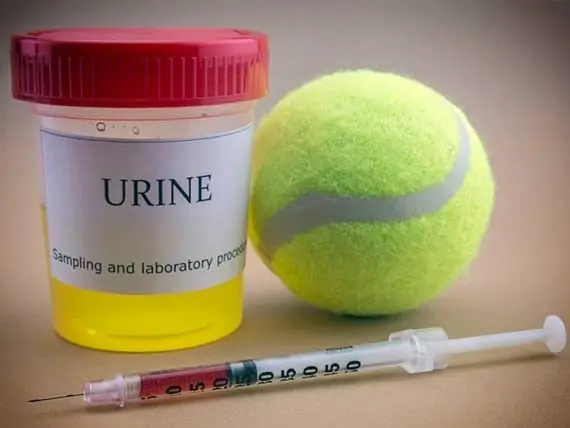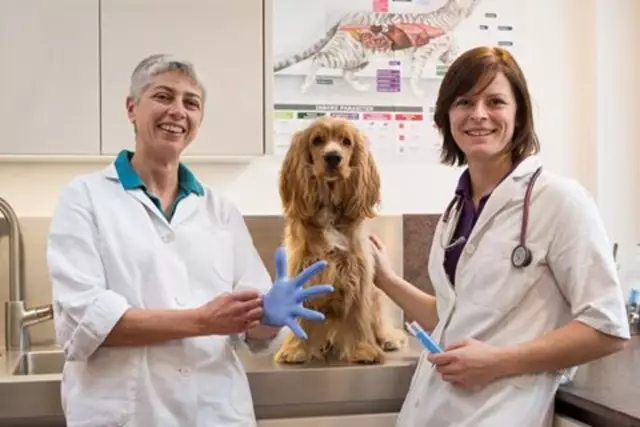
- Автор Daisy Haig [email protected].
- Public 2023-12-17 03:13.
- Последнее изменение 2025-06-01 06:48.
Так для чего вообще этот смущающий тест caca?
Достаточно стрессово, чтобы задницу вашего питомца ударили пластиковым стержнем, не так ли? Так в чем же смысл?
Вы говорите: если цель состоит в том, чтобы сделать моего питомца более здоровым и избавить его от паразитов, я доверяю вашему мнению, но я должен сказать, что проверка стула - это своего рода жестокий и необычный вид наказания. Я не получаю такого унижения, пока мне не исполнится сорок лет, верно? И фекалии не так уж и полезны, правда?
Я говорю: для начала, вам не нужно, чтобы ваш питомец поддался подлому жезлу. Свежий образец обычно легко получить утром (или днем) перед вашим ежегодным визитом или в любое время, когда у вашего питомца возникают желудочно-кишечные симптомы. На самом деле это не так уж и сложно. И если время не совсем подходящее (для достижения наилучших результатов стул должен быть не старше часа), ваша ветеринарная клиника наверняка не откажет вам в праве принести сверхсвежий образец в удобное для вас время. Обещать.
И да, исследования кала, хотя и относительно дешевые и рутинные, незаменимы. Но, как продемонстрирует этот пост, верно и то, что не все анализы кала выявляют паразитарную инфекцию у ваших домашних животных. Вот почему могут потребоваться ежегодные и / или серийные исследования кала.
Теперь о главной цели теста:
Ветеринары всегда ищут паразитов, которые могут попасть в желудочно-кишечный тракт ваших питомцев. Конечно, мы, люди, тоже можем заразиться паразитами, но наш современный образ жизни, как правило, менее способствует заражению паразитами. (Когда вы в последний раз ходили во дворе, сопя губами к земле, просто чтобы вдохнуть пару кошачьих какашек?)
Да, домашние животные заражаются множеством паразитов. Вот образцы наиболее распространенных паразитов желудочно-кишечного тракта, которые я вижу здесь [на паразитическом раю в полутропической Южной Флориде]:
Аскариды у собак и кошек.
Анкилостомы у домашних животных
Власоглавы у домашних животных
Лямблии у домашних животных

Печеночные двуустки у домашних животных
Печеночные двуустки у домашних животных
coccidia in pets
i’ll not go into the gory details on each but you can click on the links and check out the info for a better understanding of how these parasites can potentially affect your pets and even your human family.
sure, pet-popular parasites don’t often infect humans in the so-called, “developed” nations all of you reading this likely live in, but that doesn’t mean it doesn’t happen. roundworms and hookworms are still a factor in humans in the us, as is giardia, which will give you the nastiest case of diarrhea you can imagine short of amoebic dysentery.
since veterinarians are also on the front lines when it comes to public health, consider that fecal exams are not just necessary for healthy pets, they’re essential for healthy humans, too, more so if your family members are very young children, very old adults or otherwise immunocompromised (transplant patients, hiv-positive humans, chemo recipients, etc.).
how do we identify these critters in the fecal exam?
the short answer: with a microscope.
the long answer: we take a tiny sample of your pet’s stool (very fresh is always best). a few grams is enough (think an eighth of a teaspoon if that’s easier). then we put it through one of three processes.
1. the smear: we take about a half gram of stool and smear it onto a microscope slide to search for parasites (and bacteria) directly. many times we’ll see them swimming about. finding evidence of parasites in a simple smear is often indicative of severe infection.
2. the float: this method relies on mixing the stool with a special solution. it filters out the big pieces of stool in a tube or other cylindrical vessel and allows the eggs and other small critters to float up to the top, buoyed by the solution’s specific gravity. a microscope slide’s cover slip is typically used to recover the floaters. some parasites, however, aren’t amenable to flotation. eggs seem to do best through this method.
3. centrifugation: spinning the heck out of stool in a centrifuge when it’s mixed in a sugar solution picks up about 50% more parasite eggs and oocysts than through flotation. therefore, i like this method best for worm eggs, giardia, and coccidia--though i’d never go without a smear. problem is, most hospitals don’t yet use this method. it’s more expensive than others and research demonstrating it’s much greater efficacy is fairly recent.
so now you know the truth: not all fecal exams are created equal. not only does this test rely on careful selection of materials and methods, it also requires a trained eye. in our practice, for example, one of our techs detects parasites about 50% more often than the veterinarians and other techs/assistants. (that’s why we also do floats so that she can check them all at her convenience when she comes back from her day off.)
it’s also true that even a parasite-infected animal will often not come up positive on a fecal test. human error and equipment choice are factors, but so is the parasite itself. sometimes they do not make themselves known in the stool. worms sometimes aren’t shedding their eggs and subclinical (low-grade or smoldering) infections may not reveal much, either.
again, that’s why it’s important to perform this test as often as is reasonable. for all dogs and cats at least three times during the first few months of life. i want to see at least two negative tests in a row, a month apart, before i’ll feel comfortable that my patient is parasite-free.
for adults, once a year is great--that is, unless they show gastrointestinal illnesses. in this case, serial fecal tests make sense--or at least one every time the symptoms recur until a definitive diagnosis is made (whether it’s parasites or something else).
ultimately, fecal tests are a critical component of our veterinary hat of tricks. doing without may seem like the economically wisest thing in the absence of gastrointestinal symptoms, but consider: parasites can wear pets down in ways you might not expect. and it’s never wrong to be too safe in the presence of diseases that may also affect your family. ‘nuff said.
Рекомендуемые:
Важность стадирования для домашних животных с раком, Часть 3 - Анализ мочи и кала у животных, больных раком

Частью процесса определения стадии рака у домашних питомцев является тестирование всех жидкостей организма. В этой части доктор Махани объясняет процесс анализа мочи и кала. Читать далее
Что анализ крови говорит вашему ветеринару о здоровье вашего питомца

Анализ крови проводится для того, чтобы убедиться, что внутри мы такие же здоровые, как и снаружи, или для наблюдения за ранее диагностированными заболеваниями. То же самое и с животными-компаньонами. Узнайте больше о том, что анализ крови может сказать ветеринару
Анализ крови: что это значит и зачем он нужен вашему питомцу (Часть 1: CBC)

«Вы хотите 99 долларов, чтобы проверить его кровь перед стоматологическим лечением? Шутки в сторону? Я думаю, может быть, мы пропустим все стоматологические дела. Все равно меня пугает анестезия. Там, где я работаю, обычно бывает не так. По крайней мере, клиенты обычно более вежливы. Но с
Анализ крови: что это значит и зачем он нужен вашему питомцу (Часть 2: Химический анализ крови)

Оказывается, эта тема набирает обороты здесь, на Долиттлере, как и в умах ветеринаров по всему спектру медицины домашних животных. Вот почему для правильного рассмотрения этой темы требуется обработка двух постов. Хотя анализ крови становится все более распространенным компонентом медицинского обслуживания каждого питомца, не каждый ветеринар будет брать кровь вашего питомца автоматич
Вам нужен ветеринар с отличным «прикроватным» поведением? Или вам нужен отличный ветеринар?

Некоторые ветеринары - очаровательные болтуны, которые привлекают вас к заботе о своем питомце своей обаятельной белоснежной улыбкой и склонностью к льстивому освещению лампами накаливания. Другие вполне могут быть лучшими ветеринарами (или нет)… но их доставка оставляет желать лучшего. Мы, ветеринары, не всегда можем быть всем для всех. Но некоторые клиенты требуют весь пакет - при каждом посещении. И это не всегда будет происходить. Фактически, это почти всегда не
